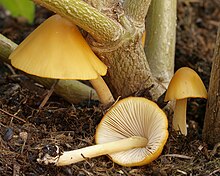Conocybe aurea
| Conocybe aurea | |
|---|---|

| |
| Scientific classification | |
| Domain: | Eukaryota |
| Kingdom: | Fungi |
| Division: | Basidiomycota |
| Class: | Agaricomycetes |
| Order: | Agaricales |
| Family: | Bolbitiaceae |
| Genus: | Conocybe |
| Species: | C. aurea |
| Binomial name | |
| Conocybe aurea (Jul.Schäff.) Hongo (1963) | |
| Synonyms[1] | |
| |
Conocybe aurea is a basidiomycete fungus in the family Bolbitiaceae.[2][3]
Taxonomy
The fungus was first described to science in 1930 by German mycologist Julius Schäffer, who called it Galera aurea. Tsuguo Hongo transferred it to the genus Conocybe in 1963.[4] In 2000, Anton Hausknecht published the variety C. aurea var. hololeuca, but this taxon is not considered to have independent taxonomic significance by Index Fungorum.[5]
The species is related to Conocybe tenera.[6]
Habitat and distribution
Conocybe aurea is a saprobic fungus that prefers to grow in nitrate-rich soils, fields, woodchip mulch, old compost, and greenhouses. A rare but widespread species, it is found in Europe, Asia, North America, South America, and New Zealand.[7]
Description
The cap is orangish yellow, and up to 5 cm in diameter.[6] The gills and stipe are beige, the former browning with age.[6]
Cap: 0.8-2.2 cm wide or more, starting globose to campanulate before expanding to convex. The surface is smooth but not sticky and is golden yellow to orangy yellow with a deeper colour in the centre of the cap. The cap dries to a chrome yellow colour with paler centre flesh when dry. Gills: Adnate and subdistant with a ventricose bulge. 1.5-3mm wide. They start whitish before developing a cinnamon colour. Stem: 2.5-6.5 cm long and 2-3mm thick and equal across its length or tapering slightly upwards with a slightly bulbous 4-6mm thick base. The interior is hollow and the exterior surface is pruinose with striations and pale yellowish but often discolours to a brownish yellow (fulvous). Flesh: Thin, soft and the same colour as the surface of the cap. Smell: Slight. Taste: Mild. Spores: 10.5-13.5 x 6-7 μm. Elliptical and smooth with a hyaline, apical germ pore. Under the microscope they are yellow. Basidia: 29-37 x 11-12 μm. Four spored. Cheilocystidia: 22-30 x 8-11 μm. Pin-headed and hyaline with a thin wall. Caulocystidia: 22-30 x 7.5-10 μm. Similar to the cheilocystidia.[4]
Etymology
The specific epithet aurea is Latin for golden yellow.[8]
Toxicity
The toxicity is unknown. Related species are known to be toxic.[9]
Similar species
Conocybe apala is common, but with a whiter and more fragile conical cap.[6]
References
- ^ "GSD Species Synonymy: Conocybe aurea (Jul. Schäff.) Hongo". Species Fungorum. CAB International. Retrieved 2015-12-08.
- ^ "Species fungorum - Conocybe aurea (Jul. Schäff.) Hongo". www.speciesfungorum.org.
- ^ "Mycobank Database - Conocybe aurea".
- ^ a b Hongo, Tsuguo (1963). "Notes on Japanese larger fungi (16)". The Journal of Japanese Botany. 38 (8): 233–240. doi:10.51033/jjapbot.38_8_4966.
- ^ Hausknecht A. (2000). "Beiträge zur Kenntnis der Bolbitiaceae 6. Die Conocybe tenera-Gruppe in Europa, Teil 1". Österreichische Zeitschrift für Pilzkunde (in German). 9: 73–109 (see p. 86).
- ^ a b c d Trudell, Steve; Ammirati, Joe (2009). Mushrooms of the Pacific Northwest. Timber Press Field Guides. Portland, OR: Timber Press. p. 180. ISBN 978-0-88192-935-5.
- ^ Overall A, Hodge V. (2015). "Conocybe aurea, a rare British native or another coloniser?". Field Mycology. 16 (1): 14–15. doi:10.1016/j.fldmyc.2015.01.006.
- ^ Harrison, Lorraine (2012). Latin for Gardeners (PDF). University of Chicago Press. p. 35. ISBN 978-0-226-00919-3.
- ^ Siegel, Noah; Schwarz, Christian (2016). Mushrooms of the Redwood Coast: A Comprehensive Guide to the Fungi of Coastal Northern California. Berkeley: Ten Speed Press. p. 145. ISBN 9781607748175.
External links
